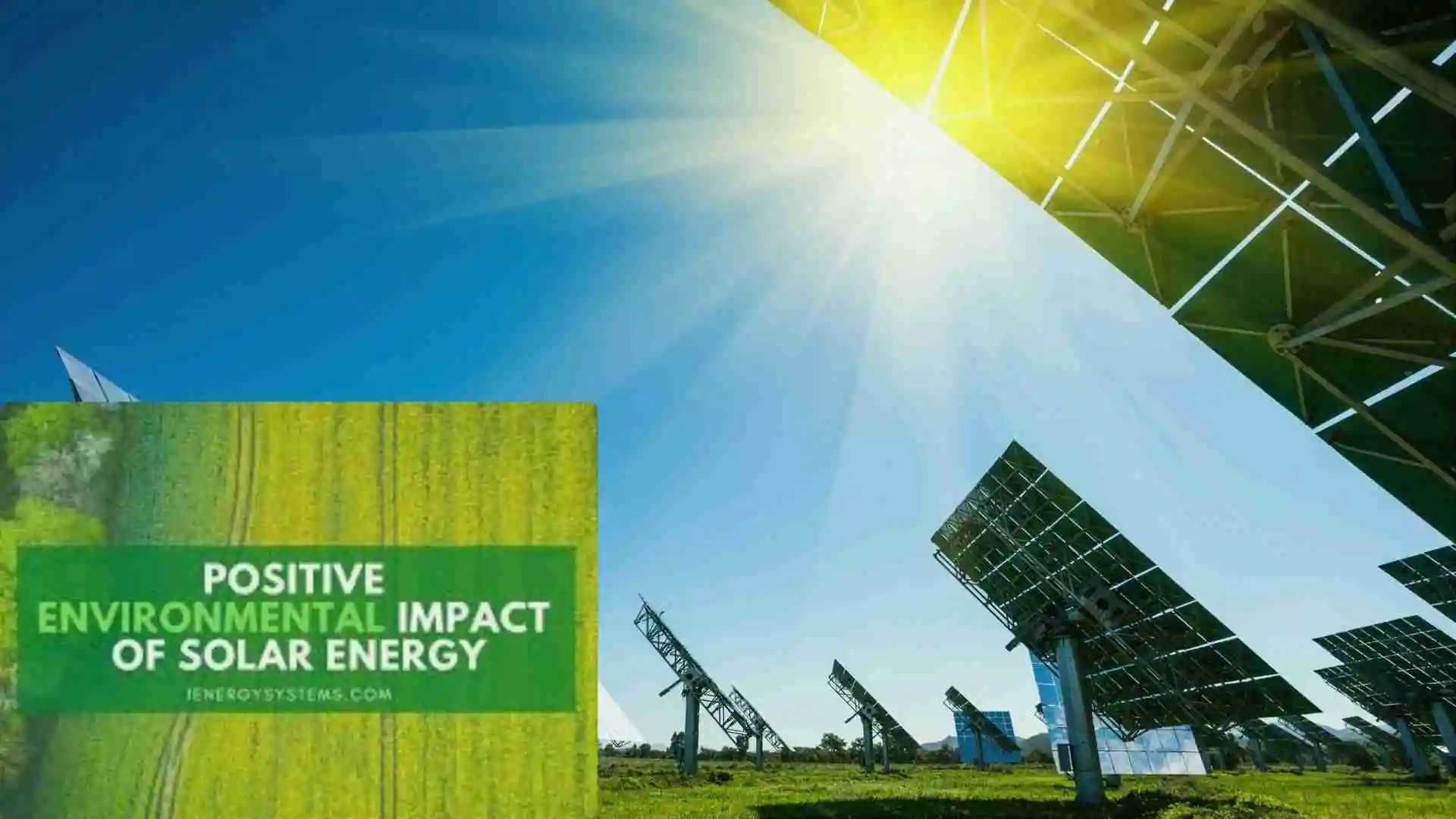Environmental Impact of Solar Energy in 2025 – What You Must Know
Solar energy has become one of the fastest-growing clean energy sources in the world. As we step into 2025, millions of homes and businesses rely on solar panels for electricity. But the big question remains, is solar energy really as eco-friendly as we think?

Understanding the environmental impact of solar energy is important before switching to it. From manufacturing to disposal, every stage of solar technology has some effect on the planet. This guide will walk you through the full picture: the good, the bad, and everything in between.
If you want to know complete details about off grid system then please visit Off Grid Solar System.
What Is the Environmental Footprint of Solar Energy?
The environmental footprint of solar energy includes all the effects it has on nature throughout its life cycle. This starts from making the panels, installing them, using them for decades, and then dealing with the waste at the end. Each step has a small impact, but much less compared to fossil fuels.
Solar panels need raw materials like silicon, silver, and aluminum. Mining and processing these materials use energy and water, and they can release pollution. However, once the panels are up and running, they produce electricity without burning fuel, releasing smoke, or harming the air. So, the overall footprint is still quite low.
Here’s a quick comparison of solar energy’s footprint across its life stages:
| Stage | Environmental Impact |
|---|---|
| Material extraction | Land use, mining pollution, energy use |
| Manufacturing | CO₂ emissions, chemical waste |
| Installation & Transport | Energy use, minor land disturbance |
| Energy production (use) | Almost zero emissions |
| End-of-life (disposal/reuse) | Waste issues, recycling challenges |
Is Solar Energy Really Clean? Understanding Life-Cycle Emissions
Solar energy is often called “clean,” but it’s important to understand the full life-cycle emissions — from production to disposal. While solar panels do not emit any carbon dioxide when producing electricity, there are emissions during manufacturing, transport, and disposal.
In 2025, improved technologies have helped reduce the carbon footprint of panel production. On average, a solar panel system produces 30–50 grams of CO₂ per kilowatt-hour over its lifetime. In comparison, coal produces over 900 grams per kWh, and natural gas around 400 grams per kWh.
Let’s look at life-cycle emissions in context:
| Energy Source | Life-Cycle CO₂ Emissions (g/kWh) |
|---|---|
| Coal | 900–1000 |
| Natural Gas | 400–500 |
| Solar (PV) | 30–50 |
| Wind | 10–20 |
| Hydro | 4–18 |
As the table shows, solar is far cleaner than fossil fuels but still has a small carbon cost. Over time, most solar systems offset their production emissions within 1–2 years of use.
Positive Environmental Effects of Solar Energy
The environmental impact of solar energy is mostly positive, especially when compared to fossil fuels. Solar power helps reduce pollution, slow down climate change, and protect natural resources. In 2025, as more countries adopt solar technology, the planet is already seeing cleaner air and lower emissions.

Solar panels generate electricity by capturing sunlight, a free and endless resource. This process does not produce smoke, noise, or harmful gases. As a result, solar energy plays a big role in building a greener and more sustainable future.
Impact on Climate Change Mitigation
The environmental impact of solar energy plays a key role in fighting climate change. Solar power systems reduce our reliance on fossil fuels, which are the largest source of global warming gases. By switching to solar, we directly lower the amount of carbon dioxide released into the air.
How solar helps fight climate change:
Every solar panel installed is a step toward a cooler, safer planet.
How Solar Energy Helps in Preserving Natural Resources
Solar energy uses one of the most abundant resources on Earth: sunlight. Unlike coal, oil, or gas, it doesn’t require mining or drilling, which damages landscapes and ecosystems. This makes solar one of the most gentle energy sources when it comes to natural resource use.
Natural resource savings with solar:
In short, solar helps the planet by using what’s free and avoiding what’s limited.
What Are the Negative Environmental Impacts of Solar Panels?
While the environmental impact of solar energy is mostly positive, there are some drawbacks that must be considered. These include pollution during manufacturing, land use challenges, and waste at the end of a panel’s life. In 2025, the solar industry is working to reduce these issues, but they haven’t been fully solved yet.
Knowing the downsides is important so that users, companies, and governments can make solar energy more sustainable and responsible.
Manufacturing and Raw Material Extraction
Producing solar panels requires raw materials like quartz, silver, copper, and aluminum. Mining these materials uses energy and can cause soil and water pollution if not managed properly. In some regions, mining also affects local communities and wildlife.

The factory process uses high heat, electricity, and chemicals to create solar cells. While newer plants are more efficient in 2025, the early stages of solar production still release some CO₂ and chemical waste.
Main concerns in manufacturing:
These impacts are usually one-time events, but they still contribute to solar energy’s total footprint.
What Are Governments and Companies Doing to Minimize Environmental Impact?
To reduce the negative environmental impact of solar energy, both governments and private companies are taking action in 2025. New technologies, smarter policies, and better recycling systems are being introduced. These efforts aim to make solar energy cleaner across its full life cycle from production to disposal.
Many countries now offer incentives for green solar manufacturing. Companies are also redesigning panels to use fewer toxic materials and to be easier to recycle. Together, these steps are helping solar energy move toward a more sustainable future.
Innovations in Sustainable Solar Technologies (2025 Updates)
In 2025, solar technology will become smarter and greener. New innovations focus on making panels with non-toxic, lightweight, and recyclable materials. Some panels are now being made with organic solar cells or perovskite layers, which reduce the need for rare metals and harsh chemicals.

There are also advances in bifacial panels (that capture sunlight on both sides), improving efficiency with less material. Smart monitoring systems reduce maintenance needs and water use. These updates help lower both the cost and environmental footprint of solar systems.
Key innovations in 2025:
These advancements bring us closer to truly eco-friendly solar energy.
How Can You Reduce the Environmental Impact of Your Solar Installation?
Even though solar is a clean energy choice, the way you choose, install, and maintain your system can affect the environment. In 2025, homeowners and businesses have more options than ever to reduce the environmental impact of solar energy at a personal level.

By selecting eco-friendly products, following best practices, and planning for end-of-life reuse or recycling, users can help make solar energy truly sustainable.
Best Practices for Solar Panel Maintenance
Maintaining your solar panels properly ensures they work efficiently for many years. Clean panels last longer, perform better, and reduce the need for early replacements which means less waste and fewer emissions from manufacturing replacements.
In 2025, smart cleaning systems and AI monitoring tools are widely available. These help reduce water use and allow early detection of faults. Avoid harsh chemicals when cleaning, and use soft brushes or water sprays when needed.
Simple maintenance tips:
Good care extends panel life and keeps your system green.
Final Thoughts – Is Solar Worth It for the Environment in 2025?
As we reach 2025, solar energy stands out as one of the most important tools for fighting climate change and reducing pollution. The environmental impact of solar energy is largely positive when compared to fossil fuels. Though it does have some downsides, these can be managed with smarter technology, better policies, and individual responsibility.
Understanding both the strengths and limitations of solar power helps people make informed choices that support a cleaner and more sustainable future.
Summary of Key Environmental Pros and Cons
To make it easier, here’s a quick comparison table showing the main environmental advantages and disadvantages of solar energy in 2025:
| Pros of Solar Energy (2025) | Cons of Solar Energy (2025) |
|---|---|
| Produces zero emissions during electricity generation | Emissions during manufacturing and transport |
| Reduces air and water pollution | Some toxic materials used in older panel types |
| Helps fight climate change (low carbon footprint) | Recycling infrastructure still under development |
| Preserves natural resources (sunlight is renewable) | Large-scale farms can disturb land and habitats |
| Uses little to no water during operation (especially PV) | Risk of solar waste if not properly managed |
| Lifespan of 25–30 years with low maintenance | Initial setup can be costly without incentives |
| Energy payback in 1–2 years | Limited efficiency in cloudy or shaded areas |
Conclusion
In 2025, solar energy continues to prove itself as a powerful and mostly positive force for the environment. It offers a clean, renewable source of electricity that helps reduce greenhouse gases, cut pollution, and preserve valuable natural resources. While there are some challenges such as manufacturing emissions, land use, and waste, these issues are being addressed through innovation, better policies, and smarter design.
For individuals and governments alike, investing in solar is not just a cleaner choice, it’s a long-term commitment to sustainability. As technology improves and recycling systems expand, solar energy is moving closer to becoming a fully circular and eco-friendly solution for the future. The more responsibly we use and manage it, the greater the benefits for our planet and generations to come.
